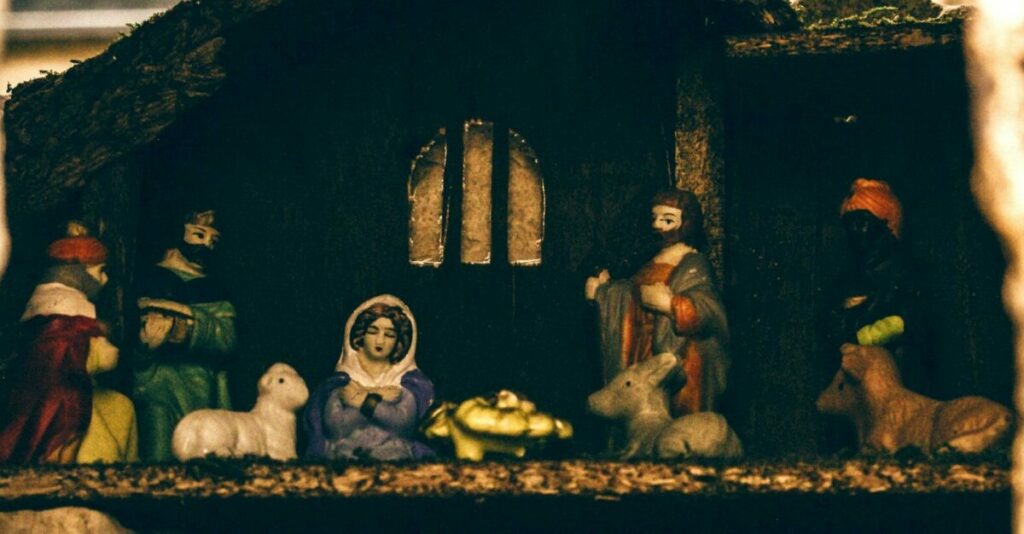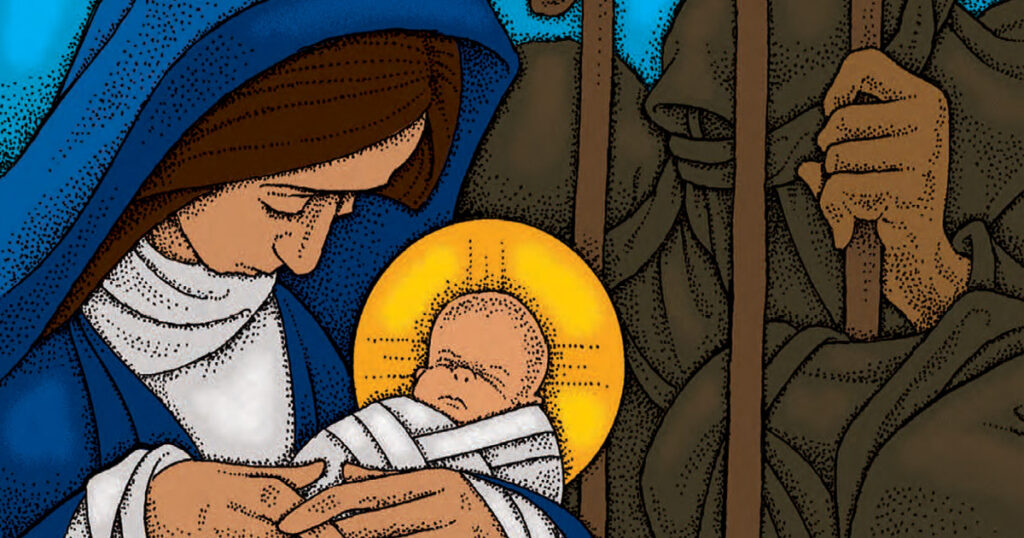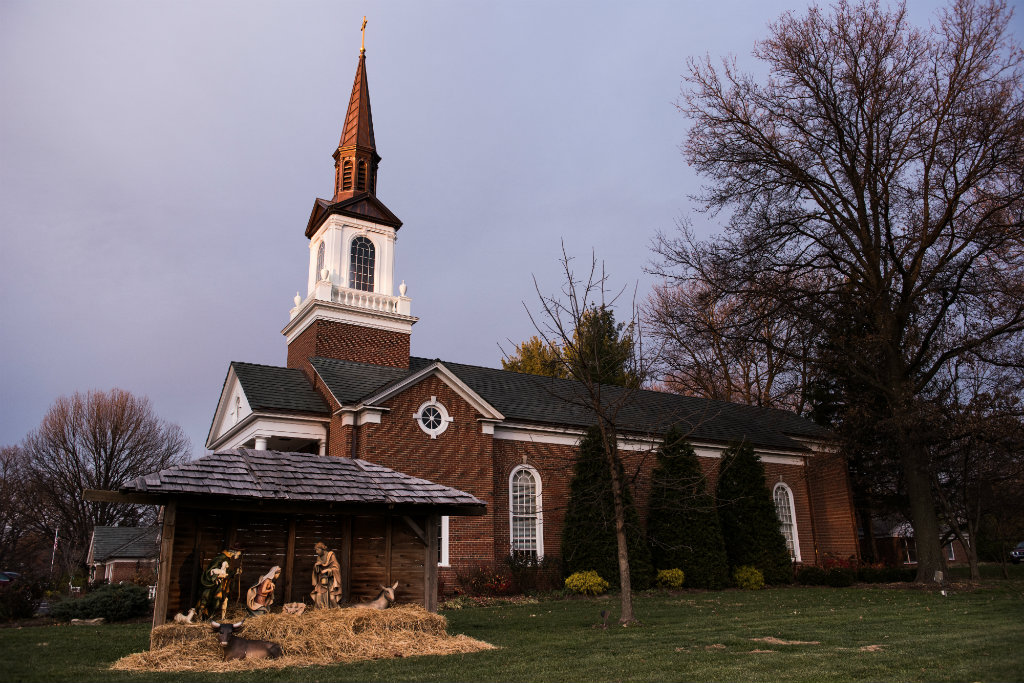by Tom Raabe
It was a nativity scene “crisis.” My sister, arms buried to her elbows in a box of bubble-wrap and Styrofoam peanuts, was near meltdown. In front of her on the table, in haphazard placement, were the contents of the box: replicas, a few inches high, of a woman dressed in a white headscarf and a patterned skirt; a man with a staff in his hand, standing in a posture of acute attention; two more men, scruffier, clad in animal skins, holding staffs; three exotic-looking characters carrying canisters and ornate boxes; a sheep, a cow, and a donkey; an angel; a backdrop of a large star; and an elevated dais upon which was a basket that was conspicuously empty. All the traditional manger scene elements were present and accounted for except . . . the most important one.
“There’s no baby Jesus!” she wailed.
My sister had purchased the set out of state; it was delivered to her house a week or so after purchase. She had failed to watch the clerk box up the figures and was now paying the price for her inattention.
For various reasons, finding a replacement figure looked unlikely: this particular manger set was going offline, personnel at the store where she bought the product had no substitute pieces on hand. It looked certain that the figures would be returned to the bubble-wrap and the box, and eventually stashed in some corner of the garage — no nativity scene could be exhibited without its most essential participant.
It was a shame. She would have to consign herself to celebrating that Christmas surrounded by her ninety-seven other nativity scenes.
Manger scenes are big business and claim a myriad of aficionados. Many church members sport collections, and at this season of year could embark upon “crèche crawls” to each other’s houses that would last long into the night if they so wished. Bronner’s Christmas Wonderland in Frankenmuth, Michigan, says it sells 500 types of them.
They emanate from every corner of the world, with designs that celebrate ethnic particularities. You can buy Peruvian sets with llamas, Hawaiian sets in which Mary and Joseph wear leis, and Eskimo scenes where the Holy Family is in an igloo. Designers of these sets take plenty of liberties as well. You can get sets comprised exclusively of dogs or bears or gnomes or leprechauns or mice or moose or, for that matter, characters from Star Wars movies or the Peanuts comic strip.
Adherence to biblical history is not exactly a priority in these replications. The manger itself was a trough for feeding animals, not a cute little crib or basket. This fact perhaps led to the inclusion of donkeys, oxen and cows in the tableaux — although no animals are recorded in the Matthew and Luke accounts. Shepherds are legit participants, having been notified immediately of Jesus’s birth, and it doesn’t seem a stretch to assume a sheep or two could have tagged along with them to the stable. Wise men are de rigueur in crèches but were not present the night of, having a two-year window to make their appearance, which renders their inclusion in a scene with shepherds highly unlikely, unless the shepherds hung around for quite a while afterward or returned every day for many months. And nothing outside the deep recesses of tradition (and the lyrics of certain favorite Christmas carols) says there were three Magi (although the Bible mentions three gifts).
Guinness chimes in with the requisite world records: The award for most figures in a living nativity scene goes to the Calne Town Council and Bible Society, in the UK, who in 2016 convened a scene with 1,254 participants. The largest figures were made of galvanized sheets of steel and were displayed in Monterrey, Mexico, in 1999: Mary and Joseph were over 17 feet tall; the baby Jesus, lying in the manger, over 6 feet long.
Francis of Assisi is credited with creating the first nativity scene. Inspired by a visit to the Holy Land, and the ostensible birthplace of Christ, he chose a cave near Greccia in central Italy in 1223 to pantomime the biblical tableaux with living humans and animals.
His crèche kicked off a major trend. Within a century manger scenes were practically required at all Italian churches and soon spread in popularity throughout the Catholic world, and eventually to the rest of Christendom. At some point, statues became suitable substitutes for living persons in these scenes, which became more and more involved and elaborate as the centuries passed.
It was a teaching vehicle for Francis’ time, when only the clerisy could understand the written theology and liturgy of the church. Dramatic portrayals of biblical events brought the Gospel to the largely illiterate world.
And it was appropriate in a different way as well, for his time, and for all times. The impetus behind the first crèche was Francis’ desire to reclaim the true meaning of Christmas. He was troubled by a culture that was secular and a tradition that centered on gift giving and not on the Gift, nor the Giver, and he was pushing back against it.
In thirteenth-century Italy, which had forgotten the reason for the season, he was putting Christ back in Christmas.
Our society, certainly no less secular than Francis’, has turned the birth of Christ into a major commercial enterprise. The Christmas season is the financial make-or-break period for many retailers. They don’t push the Christmas season into November because they want more time to pay homage to the baby Jesus.
After a few phone calls and online searches, my sister was able to procure a replacement baby Jesus for her incomplete nativity set. She ended up buying it separate on eBay and placed the missing infant Christ in the central position in her crèche.
It may be more difficult and challenging for us, amid all the snowmen and Santas of our secular society, to ensure that Christ stays the centerpiece in our Christmas celebrations. Let us join the Holy Family and shepherds and angels in focusing our gaze, and our attention, on the babe in the crib, on the greatest Gift of God, born to bear all our sins and give us eternal life.
Tom Raabe is a member of Christ Church–Lutheran in Phoenix.






